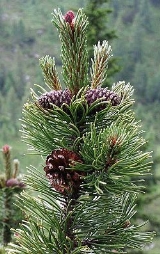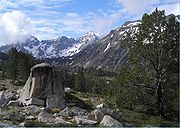
Mountain Pine
Encyclopedia
Pinus mugo, the Mountain Pine or Mugo Pine, is a high-altitude Europe
an pine
, found in the Pyrenees
, Alps
, Erzgebirge, Carpathians
, northern Apennines
and Balkan Peninsula
mountains from (mostly) 1,000 m to 2,200 m, occasionally as low as 200 m in the north of the range in Germany
and Poland
, and as high as 2,700 m in the south of the range in Bulgaria
or in the Pyrenees
.
:
 Both subspecies have similar foliage, with dark green leaves
Both subspecies have similar foliage, with dark green leaves
('needles') in pairs, 3–7 cm long. The cones
are nut-brown, 2.5-5.5 cm long, symmetrical, thin-scaled and matt texture in subsp. mugo, asymmetrical with thick scales on the upper side of the cone, thin on the lower side, and glossy, in subsp. uncinata.
The species is highly valued in horticulture
, particularly the smaller subsp. mugo. Mountain pines, especially subsp. mugo, are often used by homeowners and landscape architect
s for home security purposes. The needles deter unauthorised persons from entering private properties, and may prevent break-ins if planted under windows and near drainpipes. The aesthetic characteristics of mountain pines, in conjunction with their home security qualities, makes them a considerable alternative to artificial fence
s and wall
s. They are widely used for ornamental purposes in parts of North America
.
An old name for the species is still occasionally seen, and a typographical error "mugho" (first made in a prominent 18th century encyclopedia) is still repeated surprisingly often.
, an invasive species
that spreads in the high country of New Zealand.
s and young cones
are harvested from the wild in the Spring and left to dry in the sun over the Summer and into the Fall. The cones and buds gradually drip syrup, which is then boiled down to a concentrate and combined with sugar to make pine syrup. Menus also use the terms "pinecone syrup" or "pine cone syrup" to refer to this ingredient.
Europe
Europe is, by convention, one of the world's seven continents. Comprising the westernmost peninsula of Eurasia, Europe is generally 'divided' from Asia to its east by the watershed divides of the Ural and Caucasus Mountains, the Ural River, the Caspian and Black Seas, and the waterways connecting...
an pine
Pine
Pines are trees in the genus Pinus ,in the family Pinaceae. They make up the monotypic subfamily Pinoideae. There are about 115 species of pine, although different authorities accept between 105 and 125 species.-Etymology:...
, found in the Pyrenees
Pyrenees
The Pyrenees is a range of mountains in southwest Europe that forms a natural border between France and Spain...
, Alps
Alps
The Alps is one of the great mountain range systems of Europe, stretching from Austria and Slovenia in the east through Italy, Switzerland, Liechtenstein and Germany to France in the west....
, Erzgebirge, Carpathians
Carpathian Mountains
The Carpathian Mountains or Carpathians are a range of mountains forming an arc roughly long across Central and Eastern Europe, making them the second-longest mountain range in Europe...
, northern Apennines
Apennine mountains
The Apennines or Apennine Mountains or Greek oros but just as often used alone as a noun. The ancient Greeks and Romans typically but not always used "mountain" in the singular to mean one or a range; thus, "the Apennine mountain" refers to the entire chain and is translated "the Apennine...
and Balkan Peninsula
Balkans
The Balkans is a geopolitical and cultural region of southeastern Europe...
mountains from (mostly) 1,000 m to 2,200 m, occasionally as low as 200 m in the north of the range in Germany
Germany
Germany , officially the Federal Republic of Germany , is a federal parliamentary republic in Europe. The country consists of 16 states while the capital and largest city is Berlin. Germany covers an area of 357,021 km2 and has a largely temperate seasonal climate...
and Poland
Poland
Poland , officially the Republic of Poland , is a country in Central Europe bordered by Germany to the west; the Czech Republic and Slovakia to the south; Ukraine, Belarus and Lithuania to the east; and the Baltic Sea and Kaliningrad Oblast, a Russian exclave, to the north...
, and as high as 2,700 m in the south of the range in Bulgaria
Bulgaria
Bulgaria , officially the Republic of Bulgaria , is a parliamentary democracy within a unitary constitutional republic in Southeast Europe. The country borders Romania to the north, Serbia and Macedonia to the west, Greece and Turkey to the south, as well as the Black Sea to the east...
or in the Pyrenees
Pyrenees
The Pyrenees is a range of mountains in southwest Europe that forms a natural border between France and Spain...
.
Subspecies
There are major two subspeciesSubspecies
Subspecies in biological classification, is either a taxonomic rank subordinate to species, ora taxonomic unit in that rank . A subspecies cannot be recognized in isolation: a species will either be recognized as having no subspecies at all or two or more, never just one...
:
- Pinus mugo subsp. mugo in the east and south of the range (southern & eastern Alps, Balkan peninsula), a low, shrubby, often multi-stemmed plant to 3–6 m tall with symmetrical conesConifer coneA cone is an organ on plants in the division Pinophyta that contains the reproductive structures. The familiar woody cone is the female cone, which produces seeds. The male cones, which produce pollen, are usually herbaceous and much less conspicuous even at full maturity...
. - Pinus mugo subsp. uncinata in the west and north of the range (Pyrenees northeast to Poland), a larger, usually single-stemmed tree to 20 m tall with asymmetrical cones (the scales are much thicker on one side of the cone than the other). The two subspecies intergrade extensively (hybrid subspecies rotundata) in the western Alps and northern Carpathians. Some botanists treat the western subspecies as a separate species, Pinus uncinata, others as only a variety, Pinus mugo var. rostrata. This subspecies in the Pyrenees mark the alpine tree line or timberline, the edge of the habitat at which trees are capable of growing.

Leaf
A leaf is an organ of a vascular plant, as defined in botanical terms, and in particular in plant morphology. Foliage is a mass noun that refers to leaves as a feature of plants....
('needles') in pairs, 3–7 cm long. The cones
Conifer cone
A cone is an organ on plants in the division Pinophyta that contains the reproductive structures. The familiar woody cone is the female cone, which produces seeds. The male cones, which produce pollen, are usually herbaceous and much less conspicuous even at full maturity...
are nut-brown, 2.5-5.5 cm long, symmetrical, thin-scaled and matt texture in subsp. mugo, asymmetrical with thick scales on the upper side of the cone, thin on the lower side, and glossy, in subsp. uncinata.
The species is highly valued in horticulture
Horticulture
Horticulture is the industry and science of plant cultivation including the process of preparing soil for the planting of seeds, tubers, or cuttings. Horticulturists work and conduct research in the disciplines of plant propagation and cultivation, crop production, plant breeding and genetic...
, particularly the smaller subsp. mugo. Mountain pines, especially subsp. mugo, are often used by homeowners and landscape architect
Landscape architect
A landscape architect is a person involved in the planning, design and sometimes direction of a landscape, garden, or distinct space. The professional practice is known as landscape architecture....
s for home security purposes. The needles deter unauthorised persons from entering private properties, and may prevent break-ins if planted under windows and near drainpipes. The aesthetic characteristics of mountain pines, in conjunction with their home security qualities, makes them a considerable alternative to artificial fence
Fence
A fence is a freestanding structure designed to restrict or prevent movement across a boundary. It is generally distinguished from a wall by the lightness of its construction: a wall is usually restricted to such barriers made from solid brick or concrete, blocking vision as well as passage .Fences...
s and wall
Wall
A wall is a usually solid structure that defines and sometimes protects an area. Most commonly, a wall delineates a building and supports its superstructure, separates space in buildings into rooms, or protects or delineates a space in the open air...
s. They are widely used for ornamental purposes in parts of North America
North America
North America is a continent wholly within the Northern Hemisphere and almost wholly within the Western Hemisphere. It is also considered a northern subcontinent of the Americas...
.
An old name for the species is still occasionally seen, and a typographical error "mugho" (first made in a prominent 18th century encyclopedia) is still repeated surprisingly often.
Invasive species
P. mugo is a classed as a wilding coniferWilding conifer
Wilding conifers, also known as wilding pines, are invasive tree species in the high country of New Zealand. Millions of dollars is spent on controlling their spread....
, an invasive species
Invasive species
"Invasive species", or invasive exotics, is a nomenclature term and categorization phrase used for flora and fauna, and for specific restoration-preservation processes in native habitats, with several definitions....
that spreads in the high country of New Zealand.
Culinary use
A recent trend is the increase in use of the Mugo Pine in cooking. BudBud
In botany, a bud is an undeveloped or embryonic shoot and normally occurs in the axil of a leaf or at the tip of the stem. Once formed, a bud may remain for some time in a dormant condition, or it may form a shoot immediately. Buds may be specialized to develop flowers or short shoots, or may have...
s and young cones
Conifer cone
A cone is an organ on plants in the division Pinophyta that contains the reproductive structures. The familiar woody cone is the female cone, which produces seeds. The male cones, which produce pollen, are usually herbaceous and much less conspicuous even at full maturity...
are harvested from the wild in the Spring and left to dry in the sun over the Summer and into the Fall. The cones and buds gradually drip syrup, which is then boiled down to a concentrate and combined with sugar to make pine syrup. Menus also use the terms "pinecone syrup" or "pine cone syrup" to refer to this ingredient.

